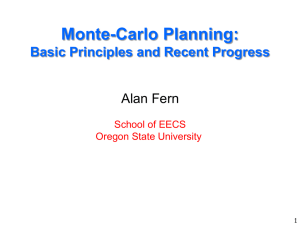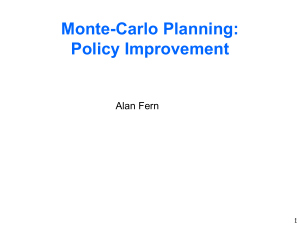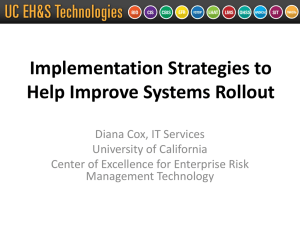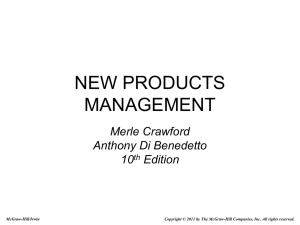Monte-Carlo Planning Tutorial
advertisement
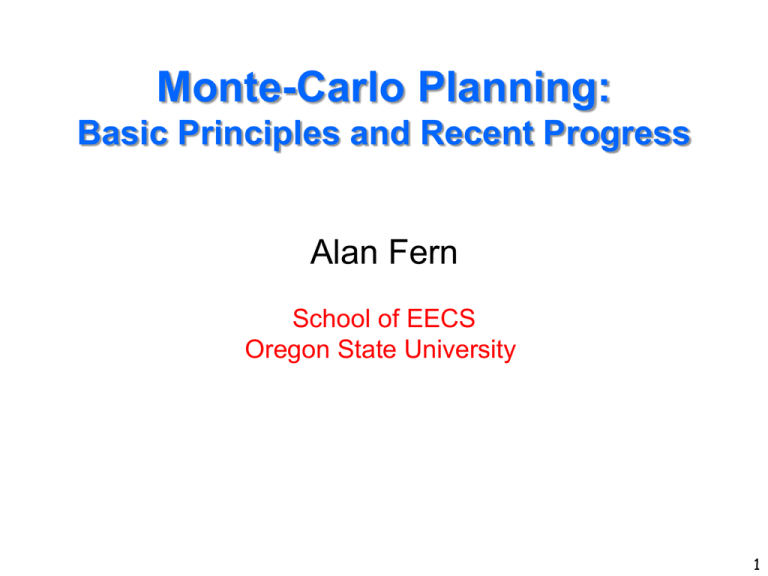
Monte-Carlo Planning: Basic Principles and Recent Progress Alan Fern School of EECS Oregon State University 1 Outline Preliminaries: Markov Decision Processes What is Monte-Carlo Planning? Uniform Monte-Carlo Single State Case (PAC Bandit) Policy rollout Sparse Sampling Adaptive Monte-Carlo Single State Case (UCB Bandit) UCT Monte-Carlo Tree Search 2 Stochastic/Probabilistic Planning: Markov Decision Process (MDP) Model State + Reward World Actions (possibly stochastic) ???? We will model the world as an MDP. 3 Markov Decision Processes An MDP has four components: S, A, PR, PT: finite state set S finite action set A Transition distribution PT(s’ | s, a) Probability of going to state s’ after taking action a in state s First-order Markov model Bounded reward distribution PR(r | s, a) Probability of receiving immediate reward r after taking action a in state s First-order Markov model 4 Graphical View of MDP St St+2 St+1 At+1 At Rt Rt+1 At+2 Rt+2 First-Order Markovian dynamics (history independence) Next state only depends on current state and current action First-Order Markovian reward process Reward only depends on current state and action 5 Policies (“plans” for MDPs) Given an MDP we wish to compute a policy Could be computed offline or online. A policy is a possibly stochastic mapping from states to actions π:S → A π(s) is action to do at state s π(s) specifies a continuously reactive controller How to measure goodness of a policy? 6 Value Function of a Policy We consider finite-horizon discounted reward, discount factor 0 ≤ β < 1 Vπ(s,h) denotes expected h-horizon discounted total reward of policy π at state s Each run of π for h steps produces a random reward sequence: R1 R2 R3 … Rh Vπ(s,h) is the expected discounted sum of this sequence h t V (s, h) E Rt | , s t 0 Optimal policy π* is policy that achieves maximum value across all states 7 Relation to Infinite Horizon Setting Often value function Vπ(s) is defined over infinite horizons for a discount factor 0 ≤ β < 1 V ( s) E [ R | , s ] t t t 0 It is easy to show that difference between Vπ(s,h) and Vπ(s) shrinks exponentially fast as h grows Rmax h V (s) V ( s, h) 1 h-horizon results apply to infinite horizon setting 8 Computing a Policy Optimal policy maximizes value at each state Optimal policies guaranteed to exist [Howard, 1960] When state and action spaces are small and MDP is known we find optimal policy in poly-time via LP Can also use value iteration or policy Iteration We are interested in the case of exponentially large state spaces. 9 Large Worlds: Model-Based Approach 1. Define a language for compactly describing MDP model, for example: Dynamic Bayesian Networks Probabilistic STRIPS/PDDL 2. Design a planning algorithm for that language Problem: more often than not, the selected language is inadequate for a particular problem, e.g. Problem size blows up Fundamental representational shortcoming 10 Large Worlds: Monte-Carlo Approach Often a simulator of a planning domain is available or can be learned from data Even when domain can’t be expressed via MDP language Fire & Emergency Response Klondike Solitaire 11 Large Worlds: Monte-Carlo Approach Often a simulator of a planning domain is available or can be learned from data Even when domain can’t be expressed via MDP language Monte-Carlo Planning: compute a good policy for an MDP by interacting with an MDP simulator World Simulator action Real World State + reward 12 Example Domains with Simulators Traffic simulators Robotics simulators Military campaign simulators Computer network simulators Emergency planning simulators large-scale disaster and municipal Sports domains (Madden Football) Board games / Video games Go / RTS In many cases Monte-Carlo techniques yield state-of-the-art performance. Even in domains where model-based planner is applicable. 13 MDP: Simulation-Based Representation A simulation-based representation gives: S, A, R, T: finite state set S (generally very large) finite action set A Stochastic, real-valued, bounded reward function R(s,a) = r Stochastically returns a reward r given input s and a Can be implemented in arbitrary programming language Stochastic transition function T(s,a) = s’ (i.e. a simulator) Stochastically returns a state s’ given input s and a Probability of returning s’ is dictated by Pr(s’ | s,a) of MDP T can be implemented in an arbitrary programming language 14 Outline Preliminaries: Markov Decision Processes What is Monte-Carlo Planning? Uniform Monte-Carlo Single State Case (Uniform Bandit) Policy rollout Sparse Sampling Adaptive Monte-Carlo Single State Case (UCB Bandit) UCT Monte-Carlo Tree Search 15 Single State Monte-Carlo Planning Suppose MDP has a single state and k actions Figure out which action has best expected reward Can sample rewards of actions using calls to simulator Sampling a is like pulling slot machine arm with random payoff function R(s,a) s a1 a2 ak … R(s,a1) R(s,a2) … R(s,ak) Multi-Armed Bandit Problem 16 PAC Bandit Objective Probably Approximately Correct (PAC) Select an arm that probably (w/ high probability) has approximately the best expected reward Use as few simulator calls (or pulls) as possible s a1 a2 ak … R(s,a1) R(s,a2) … R(s,ak) Multi-Armed Bandit Problem 17 UniformBandit Algorithm NaiveBandit from [Even-Dar et. al., 2002] 1. Pull each arm w times (uniform pulling). 2. Return arm with best average reward. s a1 a2 ak … r11 r12 … r1w r21 r22 … r2w … rk1 rk2 … rkw How large must w be to provide a PAC guarantee? 18 Aside: Additive Chernoff Bound • Let R be a random variable with maximum absolute value Z. An let ri i=1,…,w be i.i.d. samples of R • The Chernoff bound gives a bound on the probability that the average of the ri are far from E[R] Chernoff Bound 2 1 Pr E[ R] w ri exp w Z i 1 w Equivalently: With probability at least 1 we have that, w E[ R] w1 ri Z i 1 1 w ln 1 19 UniformBandit Algorithm NaiveBandit from [Even-Dar et. al., 2002] 1. Pull each arm w times (uniform pulling). 2. Return arm with best average reward. s a1 a2 ak … r11 r12 … r1w r21 r22 … r2w … rk1 rk2 … rkw How large must w be to provide a PAC guarantee? 20 UniformBandit PAC Bound With a bit of algebra and Chernoff bound we get: 2 Rmax If w ln k for all arms simultaneously w E[ R ( s, ai )] w1 rij j 1 with probability at least 1 That is, estimates of all actions are ε – accurate with probability at least 1- Thus selecting estimate with highest value is approximately optimal with high probability, or PAC 21 # Simulator Calls for UniformBandit s a1 a2 ak … R(s,a1) R(s,a2) … R(s,ak) k k Total simulator calls for PAC: k w O 2 ln Can get rid of ln(k) term with more complex algorithm [Even-Dar et. al., 2002]. 22 Outline Preliminaries: Markov Decision Processes What is Monte-Carlo Planning? Non-Adaptive Monte-Carlo Single State Case (PAC Bandit) Policy rollout Sparse Sampling Adaptive Monte-Carlo Single State Case (UCB Bandit) UCT Monte-Carlo Tree Search 23 Policy Improvement via Monte-Carlo Now consider a multi-state MDP. Suppose we have a simulator and a non-optimal policy E.g. policy could be a standard heuristic or based on intuition Can we somehow compute an improved policy? World Simulator + Base Policy action Real World State + reward 24 Policy Improvement Theorem The h-horizon Q-function Qπ(s,a,h) is defined as: expected total discounted reward of starting in state s, taking action a, and then following policy π for h-1 steps ' (s) arg maxa Q (s, a, h) Define: Theorem [Howard, 1960]: For any non-optimal policy π the policy π’ a strict improvement over π. Computing π’ amounts to finding the action that maximizes the Q-function Can we use the bandit idea to solve this? 25 Policy Improvement via Bandits s a1 ak a2 … SimQ(s,a1,π,h) SimQ(s,a2,π,h) SimQ(s,ak,π,h) Idea: define a stochastic function SimQ(s,a,π,h) that we can implement and whose expected value is Qπ(s,a,h) Use Bandit algorithm to PAC select improved action How to implement SimQ? 26 Policy Improvement via Bandits SimQ(s,a,π,h) r = R(s,a) simulate a in s s = T(s,a) for i = 1 to h-1 r = r + βi R(s, π(s)) simulate h-1 steps s = T(s, π(s)) of policy Return r Simply simulate taking a in s and following policy for h-1 steps, returning discounted sum of rewards Expected value of SimQ(s,a,π,h) is Qπ(s,a,h) 27 Policy Improvement via Bandits SimQ(s,a,π,h) r = R(s,a) simulate a in s s = T(s,a) for i = 1 to h-1 r = r + βi R(s, π(s)) simulate h-1 steps s = T(s, π(s)) of policy Return r Trajectory under a1 a2 ak Sum of rewards = SimQ(s,a1,π,h) … Sum of rewards = SimQ(s,a2,π,h) … Sum of rewards = SimQ(s,ak,π,h) … s … 28 Policy Rollout Algorithm 1. For each ai run SimQ(s,ai,π,h) w times 2. Return action with best average of SimQ results s a1 ak a2 … SimQ(s,ai,π,h) trajectories … q21 q22 … q2w … … … q11 q12 … q1w … … … Samples of SimQ(s,ai,π,h) … … Each simulates taking action ai then following π for h-1 steps. qk1 qk2 … qkw 29 Policy Rollout: # of Simulator Calls s a1 ak a2 … SimQ(s,ai,π,h) trajectories … … … … … … … … … Each simulates taking action ai then following π for h-1 steps. • For each action w calls to SimQ, each using h sim calls • Total of khw calls to the simulator 30 Multi-Stage Rollout s a1 Each step requires khw simulator calls ak a2 … Trajectories of SimQ(s,ai,Rollout(π),h) … … … … … … … … … • Two stage: compute rollout policy of rollout policy of π • Requires (khw)2 calls to the simulator for 2 stages • In general exponential in the number of stages 31 Rollout Summary We often are able to write simple, mediocre policies Network routing policy Policy for card game of Hearts Policy for game of Backgammon Solitaire playing policy Policy rollout is a general and easy way to improve upon such policies Often observe substantial improvement, e.g. Compiler instruction scheduling Backgammon Network routing Combinatorial optimization Game of GO Solitaire 32 Example: Rollout for Thoughful Solitaire [Yan et al. NIPS’04] Player Success Rate Time/Game Human Expert 36.6% 20 min (naïve) Base Policy 13.05% 0.021 sec 1 rollout 31.20% 0.67 sec 2 rollout 47.6% 7.13 sec 3 rollout 56.83% 1.5 min 4 rollout 60.51% 18 min 5 rollout 70.20% 1 hour 45 min Multiple levels of rollout can payoff but is expensive 33 Outline Preliminaries: Markov Decision Processes What is Monte-Carlo Planning? Uniform Monte-Carlo Single State Case (UniformBandit) Policy rollout Sparse Sampling Adaptive Monte-Carlo Single State Case (UCB Bandit) UCT Monte-Carlo Tree Search 34 Sparse Sampling Rollout does not guarantee optimality or near optimality Can we develop simulation-based methods that give us near optimal policies? With computation that doesn’t depend on number of states! In deterministic games and problems it is common to build a look-ahead tree at a state to determine best action Can we generalize this to general MDPs? Sparse Sampling is one such algorithm Strong theoretical guarantees of near optimality 35 MDP Basics Let V*(s,h) be the optimal value function of MDP Define Q*(s,a,h) = E[R(s,a) + V*(T(s,a),h-1)] Optimal h-horizon value of action a at state s. R(s,a) and T(s,a) return random reward and next state Optimal Policy: *(x) = argmaxa Q*(x,a,h) What if we knew V*? Can apply bandit algorithm to select action that approximately maximizes Q*(s,a,h) Bandit Approach Assuming V* s SimQ*(s,ai,h) = a1 a2 ak R(s, ai) + V*(T(s, ai),h-1) … SimQ*(s,a1,h) SimQ*(s,a2,h) SimQ*(s,ak,h) SimQ*(s,a,h) s’ = T(s,a) r = R(s,a) Return r + V*(s’,h-1) Expected value of SimQ*(s,a,h) is Q*(s,a,h) Use UniformBandit to select approximately optimal action 37 But we don’t know V* To compute SimQ*(s,a,h) need V*(s’,h-1) for any s’ Use recursive identity (Bellman’s equation): V*(s,h-1) = maxa Q*(s,a,h-1) Idea: Can recursively estimate V*(s,h-1) by running h-1 horizon bandit based on SimQ* Base Case: V*(s,0) = 0, for all s Recursive UniformBandit s SimQ(s,ai,h) a1 ak a2 Recursively generate samples of R(s, ai) + V*(T(s, ai),h-1) … q11 q12 … q1w SimQ*(s,a2,h) s11 a1 … SimQ*(s,ak,h) s12 ak … SimQ*(s11,a1,h-1) SimQ*(s11,ak,h-1) a1 … ak … SimQ*(s12,a1,h-1) SimQ*(s12,ak,h-1) 39 Sparse Sampling [Kearns et. al. 2002] This recursive UniformBandit is called Sparse Sampling Return value estimate V*(s,h) of state s and estimated optimal action a* SparseSampleTree(s,h,w) For each action a in s Q*(s,a,h) = 0 For i = 1 to w Simulate taking a in s resulting in si and reward ri [V*(si,h),a*] = SparseSample(si,h-1,w) Q*(s,a,h) = Q*(s,a,h) + ri + V*(si,h) Q*(s,a,h) = Q*(s,a,h) / w ;; estimate of Q*(s,a,h) V*(s,h) = maxa Q*(s,a,h) a* = argmaxa Q*(s,a,h) Return [V*(s,h), a*] ;; estimate of V*(s,h) # of Simulator Calls s a1 a2 ak … q11 q12 … q1w s11 a1 … SimQ*(s,a2,h) SimQ*(s,ak,h) • Can view as a tree with root s ak • Each state generates kw new states (w states for each of k bandits) • Total # of states in tree (kw)h … SimQ*(s11,a1,h-1) SimQ*(s11,ak,h-1) How large must w be? Sparse Sampling For a given desired accuracy, how large should sampling width and depth be? Answered: [Kearns et. al., 2002] Good news: can achieve near optimality for value of w independent of state-space size! First near-optimal general MDP planning algorithm whose runtime didn’t depend on size of state-space Bad news: the theoretical values are typically still intractably large---also exponential in h In practice: use small h and use heuristic at leaves (similar to minimax game-tree search) Uniform vs. Adaptive Bandits Sparse sampling wastes time on bad parts of tree Devotes equal resources to each state encountered in the tree Would like to focus on most promising parts of tree But how to control exploration of new parts of tree vs. exploiting promising parts? Need adaptive bandit algorithm that explores more effectively 43 Outline Preliminaries: Markov Decision Processes What is Monte-Carlo Planning? Uniform Monte-Carlo Single State Case (UniformBandit) Policy rollout Sparse Sampling Adaptive Monte-Carlo Single State Case (UCB Bandit) UCT Monte-Carlo Tree Search 44 Regret Minimization Bandit Objective Problem: find arm-pulling strategy such that the expected total reward at time n is close to the best possible (i.e. pulling the best arm always) UniformBandit is poor choice --- waste time on bad arms Must balance exploring machines to find good payoffs and exploiting current knowledge s a1 a2 ak … 45 UCB Adaptive Bandit Algorithm [Auer, Cesa-Bianchi, & Fischer, 2002] Q(a) : average payoff for action a based on current experience n(a) : number of pulls of arm a Action choice by UCB after n pulls: Assumes payoffs in [0,1] 2 ln n a arg maxa Q(a) n(a) * Theorem: The expected regret after n arm pulls compared to optimal behavior is bounded by O(log n) No algorithm can achieve a better loss rate 46 UCB Algorithm [Auer, Cesa-Bianchi, & Fischer, 2002] 2 ln n a arg maxa Q(a) n(a) * Value Term: favors actions that looked good historically Exploration Term: actions get an exploration bonus that grows with ln(n) Expected number of pulls of sub-optimal arm a is bounded by: 8 ln n 2 a where a is regret of arm a Doesn’t waste much time on sub-optimal arms unlike uniform! 47 UCB for Multi-State MDPs UCB-Based Policy Rollout: Use UCB to select actions instead of uniform UCB-Based Sparse Sampling Use UCB to make sampling decisions at internal tree nodes 48 UCB-based Sparse Sampling [Chang et. al. 2005] s • Use UCB instead of Uniform to direct sampling at each state a1 a2 ak • Non-uniform allocation … q11 s11 a1 … q21 q22 q31 q32 s11 ak … SimQ*(s11,a1,h-1) SimQ*(s11,ak,h-1) • But each qij sample requires waiting for an entire recursive h-1 level tree search • Better but still very expensive! Outline Preliminaries: Markov Decision Processes What is Monte-Carlo Planning? Uniform Monte-Carlo Single State Case (UniformBandit) Policy rollout Sparse Sampling Adaptive Monte-Carlo Single State Case (UCB Bandit) UCT Monte-Carlo Tree Search 50 UCT Algorithm [Kocsis & Szepesvari, 2006] Instance of Monte-Carlo Tree Search Applies principle of UCB Some nice theoretical properties Much better anytime behavior than sparse sampling Major advance in computer Go Monte-Carlo Tree Search Repeated Monte Carlo simulation of a rollout policy Each rollout adds one or more nodes to search tree Rollout policy depends on nodes already in tree At a leaf node perform a random rollout Current World State 1 Initially tree is single leaf 1 Rollout Policy 1 1 1 Terminal (reward = 1) Must select each action at a node at least once Current World State 1 1 1 Rollout Policy 1 1 0 Terminal (reward = 0) Must select each action at a node at least once Current World State 1/2 1 0 1 0 1 0 1 0 When all node actions tried once, select action according to tree policy Current World State 1/2 Tree Policy 1 0 1 0 1 0 1 0 When all node actions tried once, select action according to tree policy Current World State 1/2 Rollout Policy 0 Tree Policy 1 0 1 0 1 0 1 0 When all node actions tried once, select action according to tree policy Current World State 1/3 Tree Policy 1/2 0 0 1 0 0 1 0 0 1 0 0 What is an appropriate tree policy? Rollout policy? UCT Algorithm [Kocsis & Szepesvari, 2006] Basic UCT uses random rollout policy Tree policy is based on UCB: Q(s,a) : average reward received in current trajectories after taking action a in state s n(s,a) : number of times action a taken in s n(s) : number of times state s encountered ln n(s) UCT (s) arg maxa Q(s, a) c n(s, a) Theoretical constant that must be selected empirically in practice 58 When all node actions tried once, select action according to tree policy Current World State ln n(s) UCT (s) arg maxa Q(s, a) c n(s, a) 1/3 a1 a2 Tree Policy 1/2 0 0 1 0 0 1 0 0 1 0 0 When all node actions tried once, select action according to tree policy Current World State 1/3 Tree Policy UCT (s) arg maxa Q(s, a) c 1/2 0 0 1 0 0 1 0 0 1 0 0 ln n(s) n(s, a) UCT Recap To select an action at a state s Build a tree using N iterations of monte-carlo tree search Default policy is uniform random Tree policy is based on UCB rule Select action that maximizes Q(s,a) (note that this final action selection does not take the exploration term into account, just the Q-value estimate) The more simulations the more accurate 61 Computer Go 9x9 (smallest board) 19x19 (largest board) “Task Par Excellence for AI” (Hans Berliner) “New Drosophila of AI” (John McCarthy) “Grand Challenge Task” (David Mechner) A Brief History of Computer Go 2005: Computer Go is impossible! 2006: UCT invented and applied to 9x9 Go (Kocsis, Szepesvari; Gelly et al.) 2007: Human master level achieved at 9x9 Go (Gelly, Silver; Coulom) 2008: Human grandmaster level achieved at 9x9 Go (Teytaud et al.) Computer GO Server: 1800 ELO 2600 ELO Other Successes Klondike Solitaire (wins 40% of games) General Game Playing Competition Real-Time Strategy Games Combinatorial Optimization List is growing Usually extend UCT is some ways Some Improvements Use domain knowledge to handcraft a more intelligent default policy than random E.g. don’t choose obviously stupid actions Learn a heuristic function to evaluate positions Use the heuristic function to initialize leaf nodes (otherwise initialized to zero) Summary When you have a tough planning problem and a simulator Try Monte-Carlo planning Basic principles derive from the multi-arm bandit Policy Rollout is a great way to exploit existing policies and make them better If a good heuristic exists, then shallow sparse sampling can give good gains UCT is often quite effective especially when combined with domain knowledge 66
